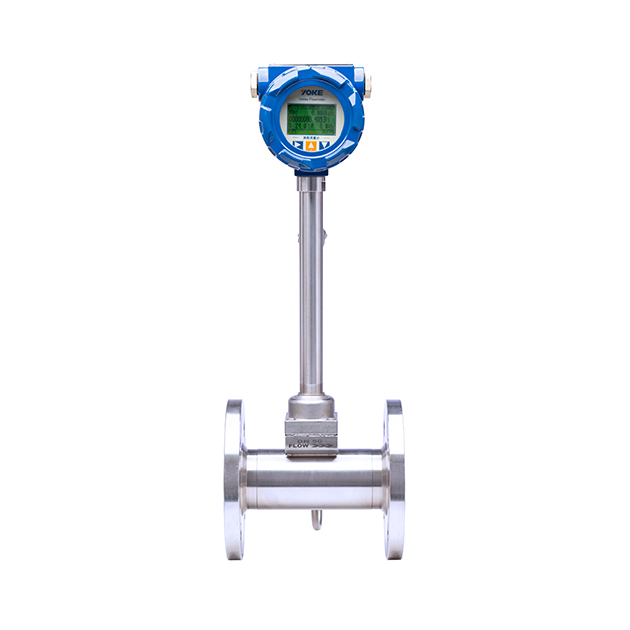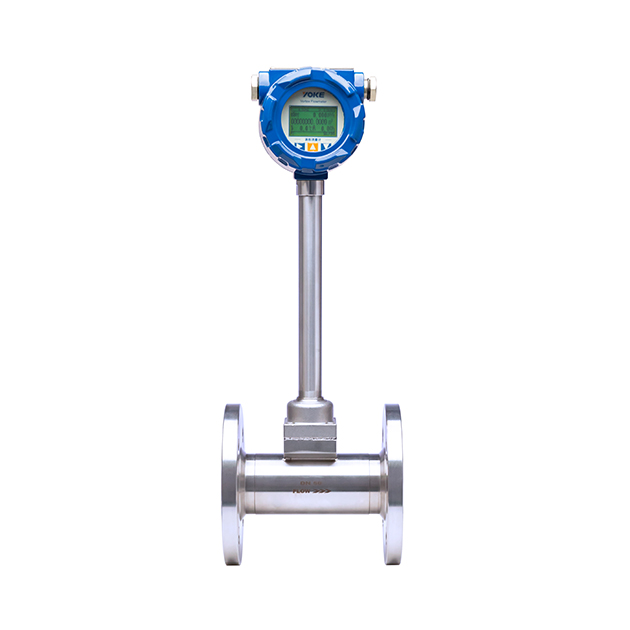



The YK-LUGB vortex flowmeter measures the volumetric flow rate, standard condition volumetric flow rate, or mass flow rate of gases, vapors, or liquids based on the Karman vortex principle. And it can be used as a flow transmitter in applications and automation control systems. This instrument adopts advanced differential technology, combined with isolation, shielding, filtering and other measures, to overcome the problems of poor seismic resistance and small signal clutter of similar products. It also adopts special sensor packaging technology and protective measures to ensure the reliability of the product. This product has the characteristics of advanced circuit, low power consumption, wide range ratio, simple structure, low resistance loss, sturdy and durable, wide application, long service life, stable operation, and easy installation and debugging.
A carefully designed product based on the comprehensive absorption of technology from developed countries and the summary of years of research and production experience
If a non streamlined vortex generator (fluid barrier) is set up in the fluid, two columns of regular vortices are alternately generated from both sides of the vortex generator. This type of vortex is called a Karman vortex street, as shown in Figure (1)。

Figure (1)
The vortices are arranged asymmetrically downstream of the vortex generator. Assuming the frequency of vortex occurrence is f, the average velocity of the incoming flow of the measured medium is V, the width of the upstream face of the vortex generator is d, and the diameter of the body is D, according to the Karman vortex street principle, the following relationship is obtained:
F=StV/d
In the formula: f - frequency of the Karman vortex generated on one side of the generating body
St Strouhal number (dimensionless number)
V - Average flow velocity of fluid
D - width of vortex generator
From this, it can be seen that the instantaneous flow rate can be calculated by measuring the separation frequency of the Karman vortex street. Among them, Strouhal number (St) is an dimensionless unknown variable,
Figure (2) shows the relationship between Strouhal number (St) and Reynolds number (Re).

Figure (2)
In the straight part of the curve table with St=0.17, the frequency of vortex release is proportional to the flow velocity, which is the measurement range of the vortex flow sensor. As long as the frequency f is detected, the flow velocity of the fluid inside the pipe can be obtained, and the volumetric flow rate can be calculated from the flow velocity V. The ratio of the measured number of pulses to the volume is called the instrument constant (K), as shown in equation (2)
K=N/Q (1/m ³)
In the formula: K=instrument constant (1/m ³).
N=number of pulses
Q=Volume flow rate (m ³)
1. No movable parts, long-term stability, simple structure for easy installation and maintenance
2. The sensor output is a pulse frequency, which is linear with the actual flow rate of the measured fluid. There is no zero drift, and the performance is very stable. There are various structural forms, including pipeline insertion flow sensors
3. High precision, typically with a measurement accuracy of ± 1% for liquids; The measurement accuracy of gas is ± 1.5%
4. The measurement range is wide, reaching up to 1:20 within the Reynolds number range of 2 × 10 ⁴~7 × 10 ⁶
5. Low pressure loss (about 1/4~1/2 of orifice flowmeter), belonging to energy-saving flow meters
6. The installation method is flexible, and it can be installed horizontally, vertically, and at different angles according to the different process pipelines on site
7. Adopting anti-interference circuit and anti vibration sensing head, it has certain anti environmental vibration performance
8. Using ultra-low power single-chip microcomputer technology, one 3V10AH lithium battery can be used for more than 5 years
9. Correction of instrument coefficient nonlinearity by software to improve measurement accuracy
10. Using EEPROM for power down protection of accumulated traffic, with a protection time greater than 10 years
Purpose:
Vortex flowmeter can be widely used for measuring the flow of various pipelines, including large, medium, and small water supply and drainage, industrial circulation, sewage treatment, oil and chemical reagents, as well as compressed air, saturated and superheated steam, natural gas, and various media.
Execution standards | Vortex flow sensor (JB/T9249-1999) |
Nominal diameter (mm) | 15,25,40,50,65,80,100,125,150,200,250,300,(200-1000 plug-in type) |
Nominal pressure (MPa) | 1.6MPa、2.5Mpa、4.0Mpa(Other customizable options) |
Usage conditions | Medium temperature: -40 ℃ -+250 ℃, -40 ℃ -+350 ℃ Environmental temperature: -20 ℃ -+60 ℃ Relative humidity: 5% -90% Atmospheric pressure: 86kpa-106kpa |
Output signal function | Pulse signal, 4-20mA |
Communication output function | RS485 communication output, HART protocol, etc |
accuracy | Pipeline type: Liquid ± 1%; Gas or steam ± 1.5%, ± 1% Insertion type: Liquid ± 2%; Gas or steam ± 2.5% |
Range degree | 1:10;1:15;1:20 |
Supply voltage | A. External power supply: 24VDC ± 15%, ripple ≤ ± 5%, suitable for 4-20mA output, pulse output, RS485, etc B. Internal power supply: 1 set of 3.0V10AH lithium batteries, which work normally when the battery voltage is between 2.0-3.0V |
output signal | Square wave pulse (excluding battery powered type): high level ≥ 5V, low level ≤ 1V; Current: 4-20mA |
Pressure loss coefficient | Complies with JB/T9249 standard Cd ≤ 2.4 |
Explosion proof mark | Intrinsic safety type: Exia Ⅱ CT2-T6, explosion-proof type: Exd Ⅱ CT2-T6 |
Protection level | Ordinary IP65 |
Applicable media | Gas, liquid, steam |

